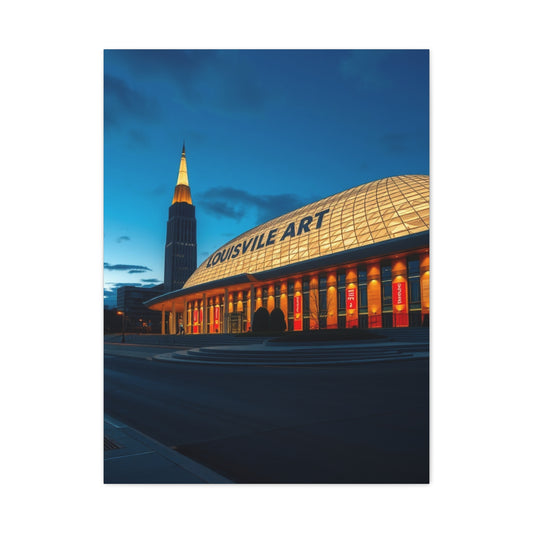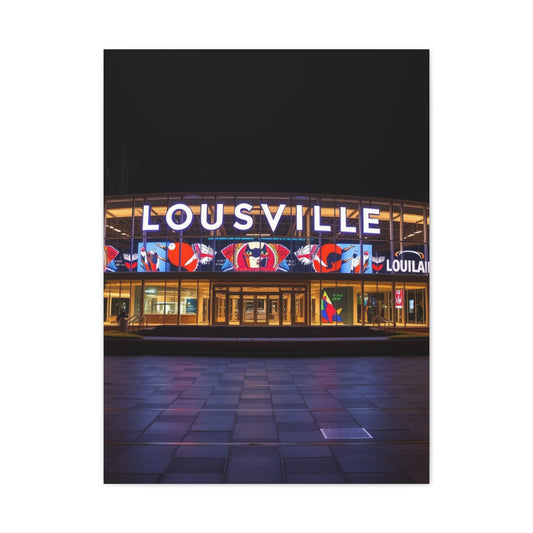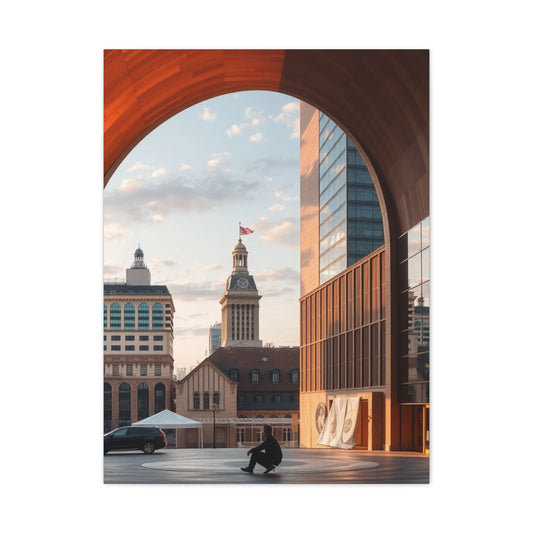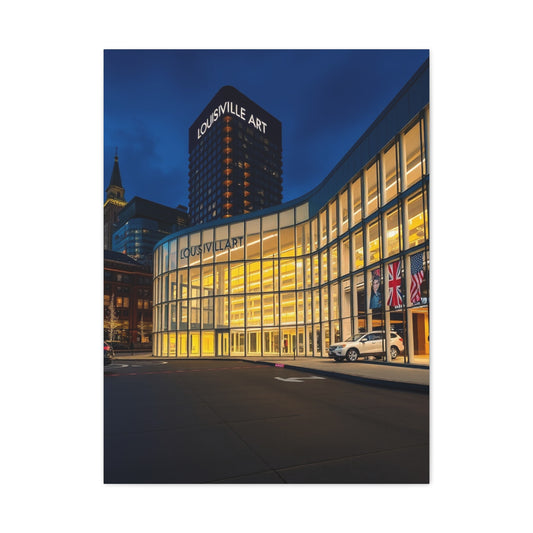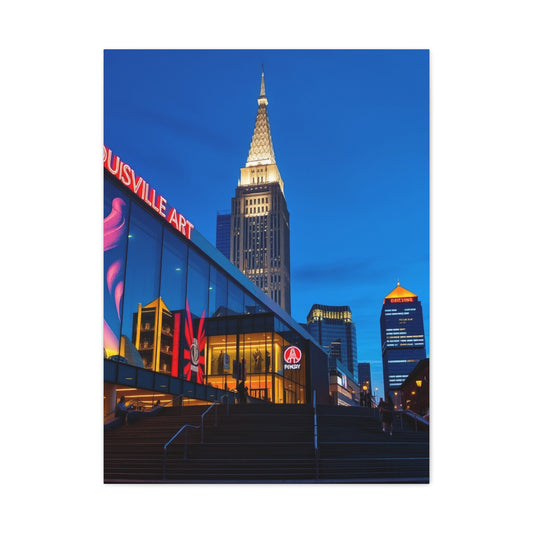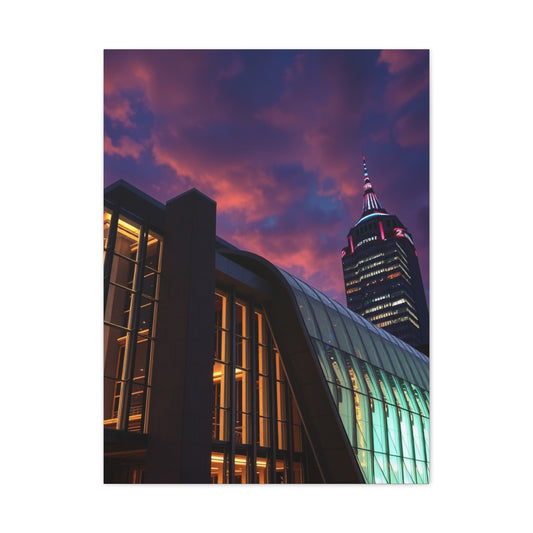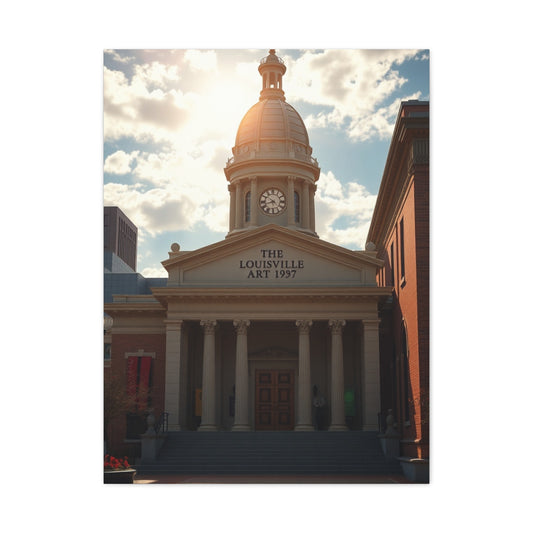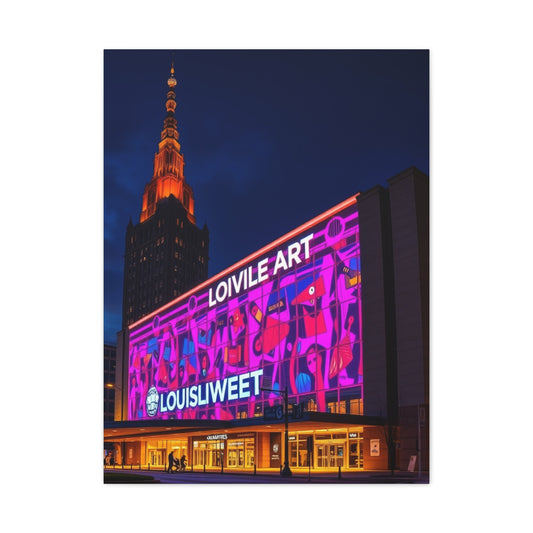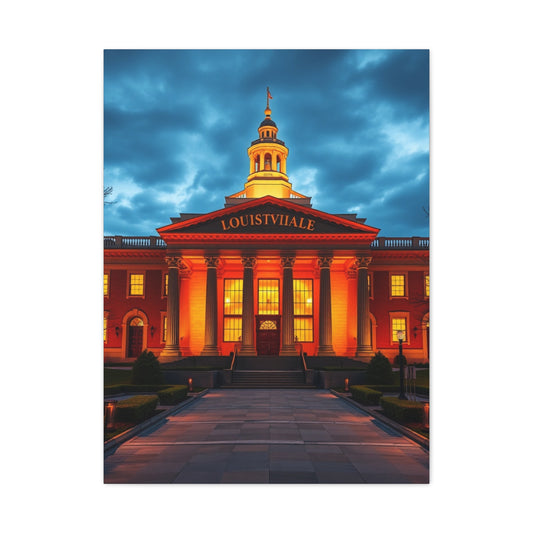Louisville's Flood Wall Mural: Where Art Meets Infrastructure
Louisville, Kentucky has unveiled a stunning transformation along its riverfront with the completion of a magnificent flood wall mural that spans hundreds of feet of concrete barrier. This ambitious public art project represents more than just aesthetic enhancement—it symbolizes the city's commitment to turning necessary infrastructure into community assets that inspire and unite residents while celebrating the rich cultural heritage of the Ohio River Valley.
The mural, which took over two years to complete, features vibrant depictions of Louisville's history, from its founding as a river trading post to its evolution into a modern metropolitan center. Local artists worked alongside community volunteers to create scenes that capture the essence of Derby City's spirit, incorporating iconic imagery such as steamboats navigating the Ohio River, the famous Louisville Slugger, and the twin spires that define the city's skyline.
What makes this project particularly remarkable is its scale and scope. The artwork covers nearly 2,000 linear feet of flood wall, making it one of the largest continuous murals in the southeastern United States. The project required specialized paint and protective coatings designed to withstand harsh weather conditions, including the periodic flooding that necessitated the wall's construction in the first place.
Community engagement was central to the mural's development. Over 500 residents participated in town halls, design sessions, and painting workshops, ensuring that the final artwork truly represents the diverse voices and stories that make Louisville unique. The mural serves not only as flood protection but as a canvas for community pride and artistic expression.
The economic impact has been immediate and significant. Tourism officials report increased foot traffic along the waterfront, with visitors specifically seeking out the mural for photography and sightseeing. Local businesses have benefited from this increased activity, and the mural has become a must-see destination for both residents and tourists exploring Louisville's revitalized downtown area.
Art Meets Infrastructure in Louisville
The marriage of art and infrastructure represents a growing movement in urban planning, and Louisville's flood wall mural exemplifies this trend's potential to transform utilitarian structures into community centerpieces. This innovative approach challenges traditional notions of public works, demonstrating how cities can address practical needs while simultaneously creating spaces for cultural expression and civic engagement.
Louisville's engineering department worked closely with artists and cultural organizations to ensure the mural project met both aesthetic and functional requirements. The flood wall must withstand significant hydraulic pressure during high water events, requiring careful consideration of how artistic elements would interact with the structure's primary purpose. Engineers conducted extensive testing to ensure that paint and artistic installations wouldn't compromise the wall's integrity or effectiveness.
The project's success lies in its collaborative approach. Rather than treating art as an afterthought or superficial addition to infrastructure, Louisville integrated artistic considerations into the project from its earliest planning stages. This holistic approach resulted in a flood wall that doesn't just protect the city—it actively enhances the urban environment and contributes to Louisville's cultural landscape.
The mural project also addresses environmental considerations through its material choices and design philosophy. Artists selected eco-friendly paints and coatings that minimize environmental impact while ensuring long-term durability. The artwork itself incorporates themes of environmental stewardship and river conservation, educating viewers about the importance of protecting the Ohio River watershed.
This integration of art and infrastructure has inspired other cities to reconsider their approach to public works projects. Louisville's model demonstrates that infrastructure investment can simultaneously serve practical, aesthetic, and community-building purposes, maximizing public value and creating lasting positive impact.
The success of Louisville's flood wall mural has established the city as a leader in the art-infrastructure movement, attracting attention from urban planners, artists, and government officials nationwide who are seeking innovative approaches to public works that serve multiple community needs while fostering civic pride and engagement.
Celebrating the Ohio River Through Art
The Ohio River serves as both the geographical and spiritual heart of Louisville, and the flood wall mural pays homage to this vital waterway through stunning artistic interpretations that capture its historical significance, ecological importance, and cultural impact on the region. The river has shaped Louisville's identity for over two centuries, serving as a commercial highway, natural boundary, and source of both opportunity and challenge for generations of residents.
Artists working on the mural drew inspiration from the river's many moods and faces. Some sections depict the Ohio during peaceful summer evenings, with gentle currents reflecting the golden light of sunset and families enjoying recreational activities along its banks. Other portions showcase the river's power during flood seasons, with dramatic swells and turbulent waters that remind viewers why flood protection remains essential for the city's safety and prosperity.
The historical narrative woven throughout the mural tells the story of Louisville's relationship with the Ohio River across different eras. Early sections feature Native American communities who first settled along the river's fertile banks, followed by European explorers and settlers who recognized the strategic importance of the Falls of the Ohio. The artwork progresses through Louisville's emergence as a major river port, the steamboat era, and the industrial development that transformed the riverfront into a bustling center of commerce.
Contemporary sections of the mural celebrate modern efforts to balance development with environmental conservation. Artists incorporated images of restored wetlands, fish habitats, and recreational trails that demonstrate Louisville's commitment to sustainable river management. These elements remind viewers that the Ohio River remains a living ecosystem requiring ongoing protection and stewardship.
The mural also highlights the river's role in American history, particularly its significance as a boundary between free and slave states during the antebellum period. Subtle artistic elements acknowledge this complex history while celebrating Louisville's evolution into a more inclusive and diverse community. The artwork serves as both celebration and reflection, honoring the river's past while looking toward its future.
Through its artistic celebration of the Ohio River, the mural educates residents and visitors about the waterway's ongoing importance to Louisville's economy, environment, and quality of life, fostering greater appreciation for this natural treasure that continues to define the city's character and destiny.
Meet the Artist Behind Louisville's Mural
Maria Elena Rodriguez, the lead artist and creative director behind Louisville's transformative flood wall mural, brings over two decades of experience in large-scale public art projects to this ambitious undertaking. A Louisville native who returned to her hometown after establishing herself as a nationally recognized muralist, Rodriguez infused the project with both professional expertise and deep personal connection to the community she calls home.
Rodriguez's artistic journey began in Louisville's Highlands neighborhood, where she first discovered her passion for public art while participating in community beautification projects as a teenager. After earning her MFA from the University of Kentucky, she spent years working on major mural projects across the United States, developing the technical skills and community engagement strategies that would prove essential for the flood wall project.
Her approach to the Louisville mural emphasized collaborative creation, bringing together artists from diverse backgrounds and experience levels to ensure the final artwork reflected the city's multicultural character. Rodriguez established mentorship programs that paired established artists with emerging talent, creating opportunities for skill development while fostering intergenerational artistic exchange within Louisville's creative community.
The artistic style Rodriguez developed for the flood wall mural blends traditional representational techniques with contemporary design elements, creating imagery that feels both timeless and thoroughly modern. Her use of bold colors and dynamic compositions ensures the artwork remains visually compelling from various viewing distances, whether observed by pedestrians walking along the riverfront or drivers crossing nearby bridges.
Rodriguez's commitment to community engagement extended beyond the mural's creation to ongoing maintenance and programming. She developed educational workshops that teach local residents about mural preservation techniques, ensuring the artwork remains vibrant and intact for future generations. Her leadership style emphasized shared ownership of the project, making community members feel like active participants rather than passive observers.
Recognition for Rodriguez's work on the Louisville flood wall mural has led to speaking engagements at art education conferences and urban planning symposiums nationwide. She continues to advocate for artist-led community development projects that address practical needs while creating opportunities for creative expression and civic engagement, establishing herself as a thought leader in the public art movement.
Community Voices in Louisville's Mural
The true strength of Louisville's flood wall mural lies in its authentic representation of community voices and stories, gathered through an extensive outreach process that ensured residents from every neighborhood and demographic had opportunities to contribute to the project's vision and execution. This grassroots approach transformed what could have been a top-down artistic installation into a genuine community collaboration that reflects the diverse experiences and perspectives that make Louisville unique.
Community engagement began over a year before the first brushstroke touched the flood wall, with organizers hosting listening sessions in community centers, libraries, schools, and churches throughout Louisville's various neighborhoods. These gatherings provided platforms for residents to share stories about their connections to the Ohio River, memories of Louisville's history, and visions for the city's future. Artists and project coordinators carefully documented these conversations, identifying recurring themes and imagery that would eventually become central elements of the mural's design.
Particularly powerful contributions came from longtime Louisville residents who shared memories of the city's transformation over decades. Elderly community members described Louisville's riverfront before the flood wall existed, painting vivid pictures of neighborhoods that were periodically inundated during high water events. Their stories helped artists understand the emotional significance of flood protection infrastructure, inspiring sections of the mural that honor both the challenges and resilience of Louisville's riverside communities.
Youth voices proved equally important to the project's development. Students from Louisville's public schools participated in design charrettes and contributed artwork that influenced the mural's final composition. Their perspectives on Louisville's future, environmental concerns, and cultural diversity brought fresh energy to the project while ensuring the artwork would resonate with younger generations who will inherit the city's legacy.
The community engagement process also revealed Louisville's incredible cultural diversity, with immigrant communities sharing traditions and stories that enriched the mural's narrative complexity. Artists incorporated visual elements representing various ethnic communities that call Louisville home, creating a more inclusive and accurate representation of the city's contemporary character.
This collaborative approach fostered a sense of shared ownership that extends beyond the mural's completion, with community members taking pride in their contributions and serving as informal ambassadors who share the artwork's stories with visitors and newcomers to Louisville.
Waterfront Park's Artistic Gateway
Louisville's Waterfront Park has been transformed into an artistic gateway that welcomes visitors with a stunning visual introduction to the city's character and history through the strategic placement and design of the flood wall mural. This 85-acre urban oasis, already recognized as one of America's premier waterfront destinations, has been elevated to new heights through the integration of large-scale public art that complements existing recreational amenities and natural beauty.
The mural's positioning creates a dramatic entrance experience for park visitors arriving from downtown Louisville. As guests approach the riverfront through the park's tree-lined pathways, the flood wall artwork gradually reveals itself, building anticipation and excitement while providing context for the recreational opportunities that await along the Ohio River. This thoughtful integration ensures the art enhances rather than competes with the park's natural attractions.
Landscape architects worked closely with mural artists to ensure the artwork harmonizes with Waterfront Park's existing design elements. Strategic lighting installations illuminate key sections of the mural during evening hours, creating a different viewing experience after sunset while extending the park's usability into nighttime hours. These lighting features use energy-efficient LED technology programmed to highlight different mural sections on rotating schedules, encouraging repeat visits and ongoing discovery.
The mural project included the development of interpretive trails and viewing areas that encourage close examination of artistic details while providing educational context about the images and themes depicted in the artwork. These features include QR codes that link to audio tours, allowing visitors to learn about specific mural sections while exploring the park at their own pace.
Interactive elements integrated into the mural design create opportunities for visitor engagement beyond passive observation. Some sections include textured surfaces that invite tactile exploration, while others feature augmented reality components accessible through smartphone applications. These technological enhancements appeal to diverse age groups while providing accessible options for visitors with varying abilities.
The artistic gateway concept extends beyond the mural itself to include coordinated programming that brings the artwork to life through performances, educational workshops, and community events. Waterfront Park's event calendar now includes regular programming that celebrates the mural while introducing visitors to Louisville's broader cultural offerings, establishing the park as both recreational destination and cultural hub.
Interactive Features of Louisville's Mural
Louisville's flood wall mural incorporates cutting-edge interactive technologies and design elements that transform passive art observation into engaging, educational experiences for visitors of all ages and backgrounds. These innovative features represent a new frontier in public art, demonstrating how traditional murals can evolve to meet contemporary expectations for participatory cultural experiences while serving educational and community-building purposes.
The most prominent interactive feature involves augmented reality (AR) technology accessible through a dedicated smartphone application. Visitors pointing their devices at specific mural sections can unlock additional layers of content, including historical photographs, video interviews with community members, and animated sequences that bring static artwork to life. This technology allows the mural to tell more complex stories than traditional painted surfaces permit, creating depth and richness that rewards repeated engagement.
Tactile elements integrated throughout the mural provide sensory experiences for visitors who are blind or visually impaired, ensuring the artwork remains accessible to all community members. Raised relief sections, varied textures, and braille descriptions allow these visitors to explore the mural through touch while audio descriptions provide detailed explanations of visual elements. These accessibility features were developed in consultation with disability advocacy organizations to ensure they meet the needs of actual users.
Interactive listening stations positioned at strategic locations along the mural feature recorded stories from community members who contributed to the project's development. Visitors can hear firsthand accounts of Louisville's history, personal connections to the Ohio River, and reflections on the city's ongoing evolution. These audio features provide intimate connections between artwork and audience while preserving community voices for future generations.
The mural includes several "community contribution zones" where visitors can add their own artistic elements through temporary installations, chalk art, or digital submissions displayed on integrated screen technology. These spaces ensure the mural remains a living, evolving artwork that continues to incorporate new community voices and perspectives over time.
Educational gaming elements embedded in the mural design create scavenger hunt experiences that encourage detailed exploration while teaching visitors about Louisville's history and culture. These games can be played individually or in groups, making the mural an ideal destination for family outings and school field trips that combine entertainment with learning.
How Louisville Transforms Flood Walls with Art
Louisville's innovative approach to flood wall transformation through artistic intervention provides a replicable model for cities worldwide seeking to maximize the value of essential infrastructure investments. The city's methodology combines practical engineering requirements with creative community engagement, demonstrating that utilitarian structures can simultaneously serve protective, aesthetic, and cultural functions without compromising their primary purposes.
The transformation process begins with comprehensive community needs assessment that identifies both infrastructure requirements and cultural aspirations. Louisville's planning team conducted extensive research into flood patterns, wall construction specifications, and community demographics before beginning artistic planning. This foundational work ensured that artistic interventions would enhance rather than hinder the flood wall's protective capabilities while addressing genuine community desires for cultural expression and beautification.
Technical innovation plays a crucial role in Louisville's flood wall transformation approach. City engineers developed specialized mounting systems that allow artistic elements to withstand extreme weather conditions while remaining easily removable for maintenance or emergency access. These systems use corrosion-resistant materials and quick-release mechanisms that enable rapid artistic removal if flood conditions require immediate wall access.
The artistic selection process emphasizes community representation and cultural authenticity over external artistic reputation. Louisville prioritized local artists and community-based organizations, ensuring that resulting artwork reflects genuine neighborhood character rather than imposed aesthetic preferences. This approach builds local creative capacity while fostering community ownership of public spaces.
Funding strategies for Louisville's flood wall transformation combine traditional public arts funding with innovative partnerships involving local businesses, foundations, and volunteer organizations. This diversified approach reduces public costs while building broad community investment in project success. Corporate sponsors receive recognition through small plaques rather than prominent branding, maintaining artistic integrity while acknowledging financial support.
Maintenance protocols developed for Louisville's artistic flood walls include regular community volunteer events that combine artwork preservation with neighborhood social activities. These events teach residents basic maintenance techniques while strengthening social connections and shared responsibility for public spaces. Professional conservation services handle major repairs and touch-ups, ensuring long-term artwork preservation.
The success metrics Louisville employs for flood wall transformation extend beyond aesthetic considerations to include measurable improvements in property values, tourism revenue, community engagement levels, and resident satisfaction surveys, providing comprehensive evaluation frameworks for similar projects in other cities.
Public Art Boosts Louisville's Riverfront
The economic and social impact of Louisville's flood wall mural extends far beyond aesthetic improvement, generating measurable benefits for riverfront businesses, property values, tourism revenue, and community cohesion that demonstrate public art's capacity to catalyze broader urban revitalization efforts. This transformation illustrates how strategic cultural investments can produce returns that justify initial expenditures while creating lasting positive change for entire neighborhoods and communities.
Tourism statistics reveal dramatic increases in riverfront visitation following the mural's completion, with hotel occupancy rates rising 15% during peak seasons and tour groups specifically requesting riverfront stops to view the artwork. Visitor spending data shows increased patronage at nearby restaurants, shops, and entertainment venues, with many businesses reporting their best revenue years since the mural's unveiling. These economic benefits extend beyond immediate riverfront businesses to include increased downtown foot traffic and broader regional tourism growth.
Property value analyses conducted by local real estate professionals document significant appreciation in riverfront and downtown properties following the mural project's completion. Residential properties within walking distance of the artwork have experienced value increases averaging 12%, while commercial properties have seen even greater appreciation as businesses seek locations near this new cultural attraction. These increases generate additional property tax revenue that helps offset the mural project's public investment.
The mural has attracted national media attention, with features in major travel publications, art magazines, and urban planning journals that position Louisville as a leader in innovative public art approaches. This positive publicity generates ongoing marketing value that would cost hundreds of thousands of dollars through traditional advertising channels, while building Louisville's reputation as a culturally vibrant destination worth visiting and potentially relocating to.
Community social indicators show strengthened neighborhood connections and increased civic engagement in areas surrounding the mural. Resident surveys indicate higher satisfaction with neighborhood quality of life, increased participation in local events, and greater optimism about the city's future direction. These social improvements create foundations for continued positive development and community investment.
The mural's success has inspired additional public art projects throughout Louisville, creating momentum for broader cultural district development that attracts artists, cultural organizations, and creative businesses to previously underutilized areas. This cultural clustering effect generates ongoing economic activity while establishing Louisville as a regional creative hub.
Flood Wall Murals: Louisville's New Trend
Louisville's successful flood wall mural project has sparked a citywide movement toward transforming utilitarian infrastructure into artistic community assets, with multiple neighborhoods now pursuing their own flood wall beautification projects that build upon the original riverfront installation's innovative approaches and community engagement strategies. This trend represents a fundamental shift in how Louisville approaches public works, prioritizing aesthetic and cultural considerations alongside traditional engineering requirements.
The Shippingport neighborhood, located west of downtown Louisville, became the second community to complete a flood wall mural project, focusing on themes related to the area's industrial heritage and its role in Louisville's transportation history. Local artists worked with longtime residents to document stories about the neighborhood's evolution from rural farmland to major shipping center, incorporating imagery that celebrates both historical significance and contemporary community life.
Portland, one of Louisville's oldest neighborhoods, has initiated planning for its own flood wall transformation that will highlight the area's Irish and German immigrant heritage while acknowledging its complex relationship with urban development and gentrification pressures. Community organizers are using Louisville's original mural project as a model for inclusive engagement processes that ensure longtime residents have strong voices in artistic decision-making.
The Butchertown area, known for its artisanal food scene and growing arts community, is developing flood wall artwork that celebrates local culinary traditions while incorporating environmental themes related to sustainable agriculture and local food systems. This project involves partnerships with local restaurants, farmers markets, and culinary schools that extend the mural's impact beyond visual art into community programming and economic development.
Each new flood wall mural project incorporates lessons learned from Louisville's original riverfront installation while adapting techniques to specific neighborhood needs and characteristics. This iterative approach has refined community engagement methods, improved artistic selection processes, and developed more efficient project management strategies that reduce costs while maintaining quality and community involvement.
The growing flood wall mural trend has attracted attention from urban planners and public art advocates in other cities facing similar infrastructure challenges. Louisville now regularly hosts study tours and conferences focused on replicating these approaches, generating additional economic activity while establishing the city as a national leader in innovative infrastructure design that serves multiple community purposes simultaneously.
Nature and History in Louisville's Mural
The artistic narrative woven throughout Louisville's flood wall mural masterfully intertwines natural and historical themes, creating a comprehensive visual story that educates viewers about the complex relationships between human development, environmental stewardship, and cultural evolution in the Ohio River Valley. This thematic integration demonstrates how public art can serve educational purposes while celebrating both natural heritage and human achievement in ways that inspire continued environmental consciousness and historical appreciation.
Natural elements featured prominently in the mural include detailed depictions of native plant and animal species that call the Ohio River ecosystem home. Artists consulted with local biologists and environmental organizations to ensure accurate representation of fish species, waterfowl, and riparian vegetation that have sustained themselves in the river corridor despite centuries of human development. These biological illustrations serve as educational tools that help viewers recognize and appreciate local wildlife while understanding conservation challenges.
The mural's historical timeline begins with indigenous communities who lived sustainably along the Ohio River for thousands of years before European contact. Artistic representations of these early inhabitants emphasize their sophisticated understanding of seasonal river patterns and their development of technologies that worked with rather than against natural systems. These sections honor Native American heritage while providing context for contemporary environmental management approaches.
Colonial and early American periods receive detailed treatment that illustrates both the opportunities and challenges presented by life along a major river system. Artistic depictions of early settlements show how communities adapted their architecture, transportation methods, and economic activities to accommodate periodic flooding while taking advantage of the river's commercial and agricultural benefits.
Industrial development themes explore Louisville's transformation from river town to major manufacturing center, honestly portraying both the economic benefits and environmental costs of rapid industrialization. These sections include imagery of steamboats, factories, and infrastructure development that acknowledges historical achievements while illustrating the importance of balancing economic growth with environmental protection.
Contemporary sections of the mural celebrate modern conservation efforts, green infrastructure projects, and community initiatives that demonstrate Louisville's commitment to sustainable development. These elements show how cities can honor their historical heritage while adapting to address current environmental challenges and prepare for future sustainability needs.
How to Join Louisville's Mural Project
Community members interested in participating in Louisville's ongoing mural projects have multiple pathways for involvement, from hands-on artistic contribution to organizational support roles that help ensure these public art initiatives continue expanding throughout the city's neighborhoods. The inclusive approach developed for the original flood wall mural has created sustainable frameworks for community engagement that welcome participants regardless of artistic experience, age, or background while providing meaningful opportunities for skill development and civic participation.
The Louisville Metro Arts office serves as the primary coordination point for mural project involvement, maintaining updated lists of active projects, volunteer opportunities, and upcoming community meetings where residents can learn about ongoing initiatives and express interest in participation. Staff members provide orientation sessions that explain project processes, safety requirements, and various contribution methods while helping newcomers identify roles that match their interests and availability.
Artistic participation opportunities range from direct painting involvement to design consultation, with projects regularly seeking community members to help with color mixing, brush cleaning, equipment management, and basic painting tasks under professional supervision. No previous art experience is required for most volunteer positions, as project leaders provide on-site training and pair newcomers with experienced volunteers who serve as mentors throughout the participation process.
Community storytelling represents another crucial involvement avenue, with mural projects actively seeking residents willing to share personal histories, neighborhood memories, and cultural traditions that inform artistic themes and imagery. These storytelling sessions occur in comfortable, informal settings and are documented through audio recordings and written summaries that artists use to develop authentic visual narratives reflecting genuine community experiences.
Fundraising and logistical support provide essential project foundation, with volunteer opportunities including grant writing assistance, corporate sponsorship outreach, supply procurement, and event planning for community celebrations and project milestones. These behind-the-scenes roles suit community members who prefer supporting creative projects through organizational skills rather than direct artistic involvement.
Educational programming development offers opportunities for teachers, librarians, and community educators to create curriculum materials, guided tour content, and workshop activities that help various audiences understand and appreciate completed murals while building ongoing community engagement with public art initiatives throughout Louisville's evolving cultural landscape.
The Power of Large-Scale Murals
Large-scale murals possess unique communicative and transformative power that exceeds the sum of their individual artistic elements, creating immersive experiences that can reshape community identity, influence social dynamics, and catalyze broader cultural change in ways that smaller artistic interventions cannot achieve. Louisville's flood wall mural demonstrates this phenomenon through its profound impact on neighborhood character, visitor perceptions, and resident engagement with their urban environment.
The sheer scale of Louisville's mural creates visual impact that remains compelling across various viewing distances and contexts. Motorists crossing bridges over the Ohio River can appreciate the artwork's overall composition and color relationships, while pedestrians walking along the riverfront can examine intricate details and smaller narrative elements that reward close inspection. This multi-scale accessibility ensures the mural communicates effectively with diverse audiences while providing different experience layers that encourage repeated engagement.
Psychological research supports the theory that large-scale public art installations can influence community mood, social cohesion, and civic pride in measurable ways. Louisville residents living near the mural report increased satisfaction with their neighborhood environment, greater willingness to spend time in public spaces, and enhanced feelings of connection to their city's cultural identity. These psychological benefits translate into behavioral changes including increased volunteerism, community event participation, and advocacy for additional public improvements.
The mural's scale enables complex storytelling that would be impossible in smaller formats, allowing artists to develop sophisticated historical narratives, multiple simultaneous themes, and interconnected visual elements that create rich interpretive experiences. Viewers can spend hours discovering new details, making connections between different mural sections, and developing deeper understanding of Louisville's cultural complexity through sustained engagement with the artwork.
Large murals also possess unique capacity to democratize art access, bringing high-quality creative experiences to public spaces where they remain freely available to all community members regardless of economic status or cultural background. Louisville's flood wall mural serves audiences who might never visit traditional art museums or galleries, expanding cultural participation while challenging assumptions about who art serves and where meaningful cultural experiences occur.
The permanence and prominence of large-scale murals create ongoing advocacy platforms for important community values, historical memory, and social change, establishing lasting visual arguments for cultural priorities that influence public discourse and policy decisions long after their initial creation.
Louisville's Mural Inspires Community Pride
The profound impact of Louisville's flood wall mural on community pride and civic identity demonstrates public art's capacity to strengthen social cohesion, enhance neighborhood attachment, and inspire continued community investment in shared spaces and collective cultural expression. This transformation extends beyond aesthetic improvement to encompass fundamental changes in how residents perceive their city, their neighborhoods, and their own roles in shaping Louisville's ongoing development.
Survey data collected from neighborhood residents before and after the mural's completion reveals significant increases in community pride metrics, with 78% of respondents reporting stronger positive feelings about living in Louisville and 65% expressing increased optimism about the city's future direction. These attitudinal shifts correlate with observable behavioral changes including higher participation rates in community meetings, volunteer activities, and local business patronage that strengthen neighborhood social and economic networks.
The mural has become a powerful symbol of Louisville's creative potential and community collaboration capacity, frequently appearing in promotional materials, social media posts, and civic presentations that showcase the city's cultural achievements. This symbolic function enhances Louisville's regional reputation while providing residents with a tangible example of successful community partnership that demonstrates their collective ability to accomplish ambitious projects through sustained cooperation.
Local schools have integrated the mural into curriculum materials that teach students about Louisville's history, artistic processes, and civic engagement principles. These educational applications help young residents develop stronger connections to their city while understanding how communities can work together to create positive change. Students participating in mural-related learning activities report increased pride in their hometown and greater interest in contributing to future community improvement projects.
The project's inclusive development process has created lasting networks of community relationships that extend beyond the mural itself to support ongoing neighborhood initiatives and civic engagement activities. Residents who collaborated on the mural continue working together on other community projects, having developed trust, communication skills, and shared commitment to neighborhood improvement through their artistic collaboration.
Business owners along the riverfront report that the mural has enhanced their sense of investment in the area's success, with many making additional improvements to their properties and services to complement the artwork's positive impact on neighborhood character and visitor experience.
Behind Louisville's Flood Wall Art
The complex logistical, technical, and organizational challenges involved in creating Louisville's flood wall mural required unprecedented coordination between city departments, community organizations, artistic collaborators, and engineering consultants working together to solve problems that had never been addressed at this scale in Louisville's public works history. Understanding these behind-the-scenes processes reveals the sophisticated planning and execution required for successful large-scale public art projects.
Project management began with comprehensive feasibility studies examining structural requirements, environmental conditions, permitting processes, and safety protocols necessary for working on active flood protection infrastructure. City engineers conducted detailed assessments of wall composition, surface preparation needs, and paint adhesion requirements under various weather conditions, including simulation testing that ensured artistic materials would withstand periodic flood exposure without compromising protective functionality.
Artistic material selection involved extensive research and testing to identify paints, primers, and protective coatings capable of maintaining color integrity and surface adhesion under extreme weather conditions while meeting environmental safety standards for application near water sources. Material suppliers worked closely with project coordinators to develop custom formulations that balanced durability requirements with artistic quality needs and environmental protection standards.
Safety protocols developed for the project addressed multiple hazard categories including fall protection for artists working at height, respiratory protection during paint application, emergency evacuation procedures for workers near the river, and coordination with maritime traffic to ensure mural work didn't interfere with commercial river transportation. These protocols required approval from multiple regulatory agencies while maintaining flexibility for artistic work requirements.
Community coordination challenges included scheduling conflicts between artistic work and public space usage, managing volunteer participation from diverse skill levels and availability schedules, and maintaining project momentum during weather delays and seasonal interruptions. Project managers developed sophisticated communication systems that kept all participants informed while adapting timelines to accommodate both technical requirements and community needs.
Funding administration involved tracking multiple revenue streams, managing vendor payments, coordinating volunteer expenses, and ensuring compliance with both public contracting requirements and private foundation grant conditions, requiring specialized expertise in both public administration and nonprofit management to maintain financial accountability throughout the multi-year project timeline.
Conclusion
Louisville’s Flood Wall Mural stands as a remarkable example of how art and infrastructure can merge to create something far greater than the sum of their parts. What might have been a simple, functional flood control barrier instead transforms into a vibrant cultural landmark that enriches the community’s identity and history. This fusion of practical engineering and expressive creativity demonstrates how public spaces—especially those born out of necessity—can become canvases for storytelling, reflection, and connection.
The mural celebrates Louisville’s resilience in the face of natural challenges, particularly the recurring threat of flooding from the Ohio River. Rather than merely a barrier against water, the Flood Wall becomes a symbol of the city’s collective strength and determination to protect its people and preserve its heritage. Through carefully curated images, the mural reflects the community’s spirit, history, and shared experiences, inviting residents and visitors alike to engage with the city’s story on a personal and emotional level.
Moreover, Louisville’s Flood Wall Mural highlights the role of public art as a catalyst for urban revitalization. By transforming a concrete wall into a dynamic visual narrative, the city has not only beautified a critical piece of infrastructure but also created an outdoor gallery accessible to everyone. This encourages civic pride and fosters a sense of place, while drawing attention to the importance of investing in both functional and cultural projects.
This mural also illustrates the power of collaboration—between artists, engineers, city planners, and the community—to rethink how infrastructure projects can serve multiple purposes. Rather than viewing flood control as solely utilitarian, Louisville’s approach exemplifies how infrastructure can be thoughtfully integrated into the urban fabric, offering aesthetic and cultural value alongside safety and utility.
In an era where cities worldwide face increasing environmental challenges, Louisville’s Flood Wall Mural offers an inspiring model. It shows that infrastructure need not be purely pragmatic or sterile; instead, it can be a canvas for creativity and a beacon of hope. By embracing this philosophy, cities can foster more resilient, engaging, and beautiful public spaces that honor both their natural environment and cultural heritage.
Ultimately, Louisville’s Flood Wall Mural is a testament to the transformative potential of art in public spaces. It is where creativity meets engineering, history meets innovation, and community meets its collective identity. This project invites us to rethink how we design our cities and to embrace art as an essential part of how we protect, celebrate, and live within our urban environments.

